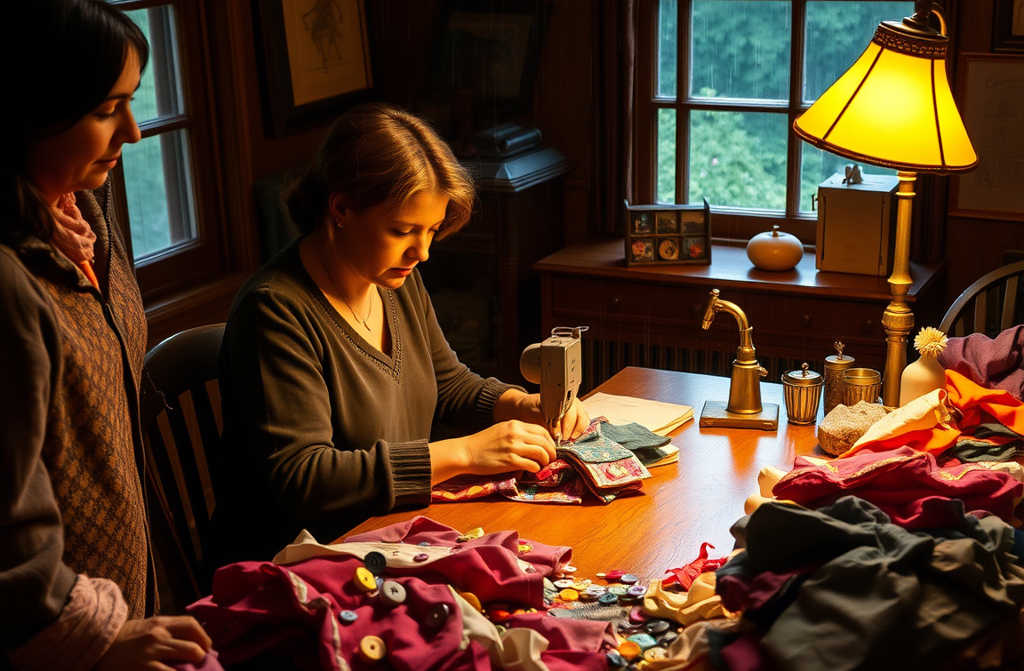З життя
When Annie Pulled the String…

When Emily tugged at the cord binding the sack, the fabric loosened slowly, rustling faintly. For a moment, it seemed as though a scent drifted from withindust, old linen, and something sweet, like a half-forgotten childhood memory. The women leaned in instinctively, caught between curiosity and hesitation.
Emily said nothing. With a single motion, she pulled open the sack and tipped it over. Clothes spilled onto the floortiny, vibrant, meticulously stitched, each one unique. Dresses pieced from remnants of silk and cotton, trousers of thick wool, striped blouses with uneven lines. All made from scraps others had discarded without a second thought.
Margaret pressed a hand to her lips. Louisa took a step back. The only sounds were the ticking of the clock and the soft patter of rain against the window.
Emily lifted her gaze.
“You’re probably wondering why I collected all this,” she said quietly. “Because nothing in life should go to waste. Every scrap mattersif someone cares enough to give it meaning.”
She bent down and picked up a small yellow dress, sewn from three mismatched fabrics. Tiny white and blue flowers were embroidered along the hem.
“These clothes arent for me,” she murmured. “I make them for the children at the orphanage by the woods. They have nothing of their own. I wanted them to feel, even for a moment, like everyone elsebeautiful, important, seen.”
The workshop fell silent. Louisa swallowed hard.
“That orphanage? The one by the old highway?”
Emily nodded.
“Yes. Every month, I leave a sack by the gate at night. I dont want them to know who brings it. It doesnt matter. What matters is that they have something to wear in the morning.”
Margaret wiped her tears with the back of her hand. No one laughed now. Steam rose from the iron in the corner like quiet smoke.
Emily spoke softly, as if to herself:
“At first, I just wanted to create something. Something from nothing. But when I saw those children, standing by the fence, watching strangers walk by, I realizedits not the fabric that matters. Its the warmth in the hands that stitch it together. Since then, Ive never thrown away a single scrap.”
The women stepped closer. Louisa touched a small wool coat with oversized buttons.
“Its warm,” she whispered. “So tiny for a three-year-old?”
“For Lily,” Emily smiled for the first time. “Her hairs like wheat. When she laughs, the whole world feels brighter.”
No one asked how she knew their names.
From that day on, the workshop changed. Margaret saved fabric scraps for Emily, Louisa brought ribbons and buttons. Even the old tailor from next door brought a box of coloured thread. “For your little princes and princesses,” he said shyly.
Emily didnt say much. She worked as she always hadquietly, precisely. But in the evenings, when the others had gone, she lit a lamp and sewed. In the golden light, only her hands were visiblesteady, patient, sure.
In time, the workshop stopped being just a workplace. It became something elsea place where everyone learned that even scraps could be made into something beautiful. That kindness didnt need words, only action.
One rainy Saturday, the women went together to the orphanage. For the first time, Emily wasnt alone. The children ran barefoot into the yard, grinning. When they pulled the sacks from the car, the little ones clapped.
Margaret would later say shed never seen such pure joy. Each child held their clothes like treasure. A girl pulled a dress over her tattered jumper and danced in the rain. A boy in an oversized coat laughed, declaring he looked like a “proper gentleman.”
Emily stood at the back, silent. She only watched as small hands touched her work. Margaret noticed her wiping away tears but said nothing. She understood.
When they returned to the workshop, tired and drenched but happy, a note hung above the mirror:
“From what others throw away, you can build a world.”
No one admitted to writing it. But everyone knew.
After that, bags of fabric began appearing at the workshop, left by townsfolk. Students from the tailoring school came to help sew. Evenings in the old building, a single lamp glowedand the silhouette of a woman, still stitching.
Years later, when the workshop moved to a new building, someone left a pencilled note on the old wall:
“From scraps, you can sew hope.”
And to this day, at the orphanage by the old road, children wear Emilys clothes. Some bear uneven stitches, gentle traces of hands that knew how to turn shame into dignity, silence into care, and scrapsinto love.
No one laughs at her sacks anymore.
Because now they all knowinside each one isnt just fabric. Its a heart that can stitch the world back together.

















